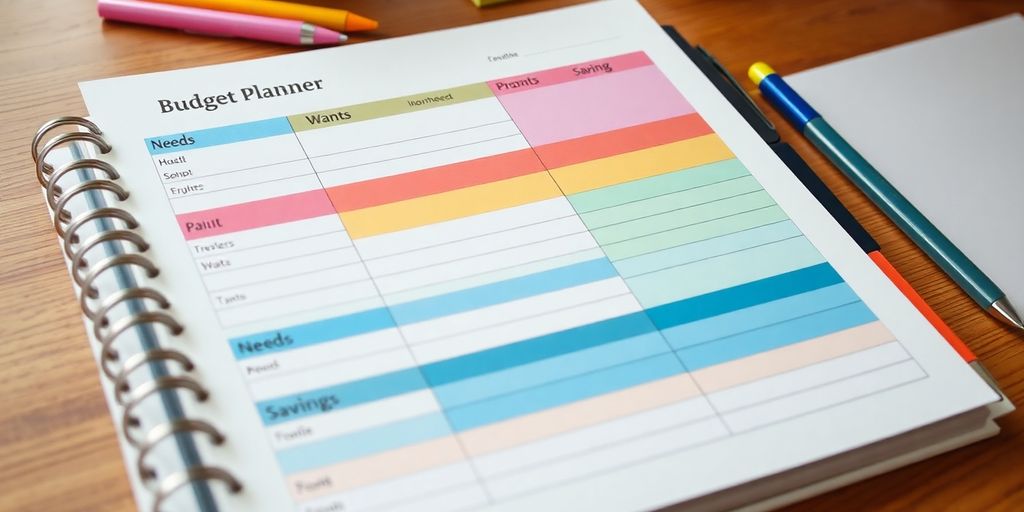
50/30/20 Budgeting Rule: A Simple Way to Manage Your Money
Ever feel like your money just disappears? The 50/30/20 budgeting rule might be your answer. It's a simple way to split your income into three parts: needs, wants, and savings. This method has gained popularity because it’s easy to follow and helps manage finances without getting into the nitty-gritty details. Let's break it down and see how this rule can work for you.
Summary
- The 50/30/20 rule divides your after-tax income into three categories: 50% for needs, 30% for wants, and 20% for savings.
- This budgeting method is popular for its simplicity and ease of use, making it accessible for everyone, even those new to budgeting.
- Using the 50/30/20 rule can help you balance essential expenses with savings and discretionary spending.
- Adjustments to the percentages can be made to better fit personal financial goals or high-cost living areas.
- The rule encourages consistent savings habits while allowing room for enjoyment and flexibility in spending.
Understanding the 50/30/20 Budgeting Rule

Origins and Popularity
The 50/30/20 budgeting rule wasn't just plucked out of thin air; it's got some history. This method was popularized by Elizabeth Warren, a U.S. Senator, and her daughter Amelia Warren Tyagi in their book "All Your Worth: The Ultimate Lifetime Money Plan." They didn't just make it up on a whim. It was based on years of research and financial planning experience. The idea caught on because it was simple and easy to grasp. People were tired of complicated budgets that required a PhD to understand. This rule became a hit because it was straightforward and practical.
Basic Principles Explained
So, what’s the deal with this budgeting rule? It's all about dividing your after-tax income into three chunks: 50% for needs, 30% for wants, and 20% for savings.
- Needs (50%): These are your must-haves, like rent, groceries, insurance, and utilities. Basically, stuff you can't live without.
- Wants (30%): This is your fun money. Eating out, Netflix, that new gadget you’ve been eyeing.
- Savings (20%): This chunk is for your future. Think of it as a gift to your future self. It's for savings, investments, or paying off debt.
This division makes it easier to see where your money should go, without having to track every single penny.
Why It Works for Many
The beauty of the 50/30/20 rule is in its simplicity. It doesn’t require you to track every dollar, just the big picture. This method works because it’s flexible. If you get a raise, your budget automatically adjusts. And if your income drops, you can quickly see where to cut back.
It's not about being rigid; it's about having a guide that helps you make better choices with your money.
Plus, it helps you focus on priorities — ensuring your needs are met, enjoying life a bit, and saving for the future. This balance is why so many people find it effective. It's not just a budget; it's a way to live within your means while planning for the future.
For more insights on how this rule helps balance essential living expenses, check out the detailed breakdown on how the 50/30/20 rule can be applied to your everyday life.
How to Implement the 50/30/20 Budgeting Rule
Tracking Your Expenses
First off, you gotta know where your money goes. Spend a month or two jotting down every penny you spend. This might seem like a hassle, but trust me, it's worth it. You'll start to notice patterns and maybe even some surprises in your spending habits. Use a simple spreadsheet or an app to make this easier. Once you have a clear picture, categorize your expenses into needs, wants, and savings. This groundwork is crucial for sticking to the 50/30/20 rule.
Categorizing Your Spending
Next, take a hard look at your expenses and break them down into three main categories: needs, wants, and savings. Needs are your essentials like rent, groceries, and utilities – stuff you can't live without. Wants are those little extras that make life fun, like dining out or that new gadget you’ve been eyeing. Finally, savings should be a fixed part of your budget, whether it's for an emergency fund or retirement. The idea is to spend 50% on needs, 30% on wants, and stash 20% away.
Adjusting to Fit Your Needs
Life isn't one-size-fits-all, and neither is this rule. You might need to tweak these percentages a bit. Maybe your rent is super high, or you're saving for a big trip. Adjust the numbers to fit your lifestyle, but try to stick as close to the original rule as possible. The key is to find a balance that works for you and keeps you on track with your financial goals.
Implementing the 50/30/20 rule is like giving your money a job. It's about directing your income in a way that covers your essentials, allows some fun, and ensures you're saving for the future. It might take some time to get it right, but once you do, it can really change how you handle your finances.
Benefits of the 50/30/20 Budgeting Rule

Simplifying Financial Management
The 50/30/20 budgeting rule offers a straightforward way to manage money. By splitting your income into three clear categories, it removes the guesswork from budgeting. This method means you don't have to spend hours poring over spreadsheets or making complex calculations. Instead, you can quickly allocate your funds and move on with your day. It's like having a financial map that guides you without needing a degree in finance.
Encouraging Savings Habits
One of the standout features of this rule is its emphasis on savings. By setting aside 20% of your income, you're building a cushion for the future. This isn't just about saving for a rainy day; it's about creating a habit that secures your financial future. Whether it's for retirement, an emergency fund, or other long-term goals, this approach nudges you to prioritize savings consistently.
Balancing Needs and Wants
The beauty of the 50/30/20 rule is in its balance. By allocating 50% to needs and 30% to wants, it ensures that you cover your essentials while still enjoying life. You don't feel deprived because there's room for those little luxuries that make life enjoyable. It's a system that acknowledges life isn't just about paying bills but also about living.
The 50/30/20 rule doesn't just help you manage your money; it changes how you think about spending and saving. It simplifies choices, making it easier to stick to a budget without feeling restricted. It's a practical approach that fits into everyday life, helping you find a balance between living for today and planning for tomorrow.
Common Challenges and Solutions
Dealing with High Living Costs
Living in a city where the cost of living is high can make sticking to the 50/30/20 rule tough. Housing, transportation, and groceries can eat up a big part of your budget. To manage this, you might need to tweak the rule a bit. Consider these steps:
- Prioritize essential expenses: Focus on cutting costs in areas that aren't essential, like dining out or entertainment.
- Look for alternatives: Use public transportation instead of owning a car, or shop at discount stores.
- Adjust your percentages: You might need to allocate more than 50% for needs if you're in a high-cost area.
Adjusting Percentages for Personal Goals
The standard 50/30/20 split might not align with everyone's financial goals. If you're saving for a big purchase or paying off debt, you might want to adjust these ratios. Here’s how:
- Increase savings: If your goal is to save more, consider shifting some funds from the 'wants' category to savings.
- Focus on debt repayment: If debt is a priority, allocate more towards it, even if it means cutting back on wants temporarily.
- Reevaluate regularly: Assess your financial situation often to ensure your budget aligns with your goals.
Staying Consistent with the Plan
Sticking to a budget is easier said than done. Life's unexpected expenses can throw you off track. Here are some tips to stay consistent:
- Automate savings: Set up automatic transfers to your savings account to ensure you save regularly.
- Track your spending: Use budgeting apps to keep an eye on where your money goes.
- Be flexible: Allow yourself some wiggle room for occasional splurges to avoid feeling deprived.
While the 50/30/20 rule provides a solid framework, it's important to adapt it to your personal circumstances. Remember, the goal is to create a budget that works for you, not against you.
Is the 50/30/20 Budgeting Rule Right for You?
Assessing Your Financial Situation
Before diving into any budgeting strategy, it's important to take a good look at your current financial situation. Ask yourself a few questions: Are your expenses generally stable, or do they fluctuate wildly? Do you have any major debts to tackle, or is your financial slate relatively clean? Understanding where you stand financially is the first step to deciding if the 50/30/20 rule can fit into your life.
Comparing with Other Budgeting Methods
There are many ways to budget, and the 50/30/20 rule is just one of them. Some people prefer the envelope method, while others might lean towards zero-based budgeting. Each has its own pros and cons. The 50/30/20 rule simplifies things by dividing your income into three main categories: needs, wants, and savings. This might be a refreshing change if you're tired of tracking every penny.
Making Informed Decisions
After assessing your finances and comparing different methods, it's time to make a decision. Consider your personal goals and lifestyle. Are you looking for a simple framework to follow, or do you need something more detailed? If you decide to go with the 50/30/20 rule, remember that it's flexible. You can tweak the percentages to better fit your needs. This rule is a guideline, not a hard rule, so feel free to adjust it as your financial situation changes.
Real-Life Examples of the 50/30/20 Budgeting Rule
Case Study: Young Professional
Meet Jamie, a young professional just starting out in her career. Jamie earns $3,000 a month after taxes. Using the 50/30/20 budget rule, she allocates her income as follows:
- Needs (50%): Jamie spends $1,500 on rent, utilities, groceries, and transportation. These are her non-negotiable expenses.
- Wants (30%): She sets aside $900 for dining out, entertainment, and hobbies. This is her fun money.
- Savings (20%): Jamie saves $600 each month. This goes into her emergency fund and retirement savings.
Jamie finds this approach simple and effective. She enjoys her lifestyle while building a solid financial foundation.
Case Study: Family Budgeting
The Smith family, with two kids, brings home $5,000 monthly. They apply the 50/30/20 rule to manage their finances:
- Needs (50%): $2,500 covers mortgage, groceries, and childcare. These are their essential expenses.
- Wants (30%): $1,500 is reserved for family outings, vacations, and personal spending.
- Savings (20%): They save $1,000. This goes towards college funds and paying off debt.
This structure helps the Smiths balance their responsibilities and enjoy family time without financial stress.
Lessons Learned from Real Users
Real users of the 50/30/20 rule often share these insights:
- Flexibility is Key: Adjusting the percentages can be necessary, especially in high-cost areas.
- Consistency Matters: Regularly tracking expenses ensures adherence to the plan.
- Long-term Benefits: Over time, users report improved savings habits and financial security.
"The 50/30/20 rule taught me discipline with my spending," says Jamie. "It’s not just about budgeting; it’s about making smart choices for the future."
Wrapping It Up
So, there you have it—the 50/30/20 budgeting rule in a nutshell. It's a pretty straightforward way to keep your finances in check without getting bogged down in complicated spreadsheets or endless calculations. By splitting your income into needs, wants, and savings, you can make sure you're covering the essentials, enjoying life a bit, and still putting something away for the future. Sure, it might take a little tweaking to fit your personal situation, especially if you're dealing with high living costs or specific financial goals. But once you get the hang of it, this method can really help you stay on top of your money game. Give it a shot and see how it works for you. Who knows, it might just be the simple solution you've been looking for to manage your money better.
Frequently Asked Questions
What is the 50/30/20 budget rule?
The 50/30/20 budget rule is a simple way to divide your after-tax income into three parts: 50% for needs, 30% for wants, and 20% for savings. It's a straightforward method to help you manage your money better.
How do I start using the 50/30/20 budget rule?
Begin by calculating your after-tax income. Then, keep track of your spending to see where it fits into the needs, wants, and savings categories. Adjust your spending to match the 50/30/20 percentages.
Can I change the percentages in the 50/30/20 rule?
Yes, you can adjust the percentages to fit your personal situation. For example, if you live in a place with high living costs, you might need to spend more on needs and less on wants.
What are examples of 'needs' in the 50/30/20 rule?
Needs are things you must have to live, like rent, groceries, utilities, and healthcare. They should take up 50% of your after-tax income.
Why is saving 20% of income important?
Saving 20% helps you build a safety net for emergencies, plan for retirement, and achieve long-term financial goals. It's a way to ensure you're prepared for the future.
Is the 50/30/20 rule suitable for everyone?
The rule works for many people because it's simple and flexible. However, it may not fit everyone's needs, especially if your income or expenses are unusual. You can tweak the rule to better suit your lifestyle.